|
Rossella (sponge)
''Rosella'' is a genus of glass sponges in the family Rossellidae. It is found in the Antarctic and sub-Antarctic regions. Description Species are thick-walled saccular sponges. Calycocomes (six rayed spicules with secondary rays emanating from a solid calyx) are always present. They are often accompanied by spherical discohexactines (six rayed spicules with secondary rays ending as small discs), mesodiscohexasters (microscleres with primary rays that are rearranged by fusion to form eight compound primary rays situated at the corners of a cube. Secondary rays end as small discs) and microdiscohexasters (smaller forms of mesodiscohexasters). Dermalia (outer spicules of any size class) are usually pentactines, sometimes with stauractines (cross-like spicules with four perpendicular rays) and hexactines. Prostalia lateralia (large protruding spicules), when present, are monaxons (spicules with a single axis) and sometimes pentactines. The hypodermal pentactine spicules (spi ... [...More Info...] [...Related Items...] OR: [Wikipedia] [Google] [Baidu] |
Rossella Veluta
Rossella may refer to: * Rossella (given name), female given name * ''Rossella'' (TV series), an Italian television series * ''Rossella'' (sponge), a genus of sponges in the family Rossellidae] See also * Rosella (other) '' Rosella'' is a genus of broad-tailed parrots endemic to Australasia. Rosella may also refer to: * Roselle (plant), a species of hibiscus (''Hibiscus sabdariffa''), also known as "rosella". ** A drink made from that plant, also called " Hibiscu ... * Rozella (other) {{disambiguation ... [...More Info...] [...Related Items...] OR: [Wikipedia] [Google] [Baidu] |
Nematode
The nematodes ( or ; ; ), roundworms or eelworms constitute the phylum Nematoda. Species in the phylum inhabit a broad range of environments. Most species are free-living, feeding on microorganisms, but many are parasitic. Parasitic worms (helminths) are the cause of soil-transmitted helminthiases. They are classified along with arthropods, tardigrades and other moulting animals in the clade Ecdysozoa. Unlike the flatworms, nematodes have a tubular digestive system, with openings at both ends. Like tardigrades, they have a reduced number of Hox genes, but their sister phylum Nematomorpha has kept the ancestral protostome Hox genotype, which shows that the reduction has occurred within the nematode phylum. Nematode species can be difficult to distinguish from one another. Consequently, estimates of the number of nematode species are uncertain. A 2013 survey of animal biodiversity suggested there are over 25,000. Estimates of the total number of extant species are su ... [...More Info...] [...Related Items...] OR: [Wikipedia] [Google] [Baidu] |
Rossella Nuda
Rossella may refer to: * Rossella (given name) Rossella is a female given name. Notable people with the name include: * Rossella Biscotti, Italian visual artist * Rossella Brescia, Italian television presenter * Rossella Callovi, Italian road and track racing cyclist * Rossella Como, Italian a ..., female given name * ''Rossella'' (TV series), an Italian television series * ''Rossella'' (sponge), a genus of sponges in the family Rossellidae] See also * Rosella (other) * Rozella (other) {{disambiguation ... [...More Info...] [...Related Items...] OR: [Wikipedia] [Google] [Baidu] |
Rossella Mixta
Rossella may refer to: * Rossella (given name), female given name * ''Rossella'' (TV series), an Italian television series * ''Rossella'' (sponge), a genus of sponges in the family Rossellidae] See also * Rosella (other) '' Rosella'' is a genus of broad-tailed parrots endemic to Australasia. Rosella may also refer to: * Roselle (plant), a species of hibiscus (''Hibiscus sabdariffa''), also known as "rosella". ** A drink made from that plant, also called " Hibiscu ... * Rozella (other) {{disambiguation ... [...More Info...] [...Related Items...] OR: [Wikipedia] [Google] [Baidu] |
